
views
Where do truffles grow?
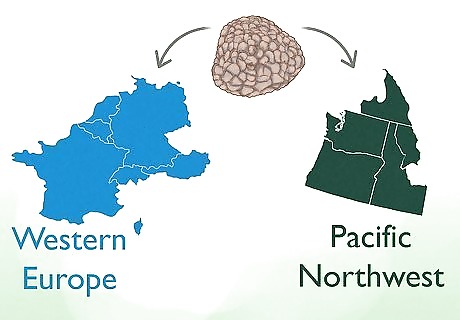
Popular truffles are found in West Europe and the Pacific Northwest. Truffles are found underground in moist, warm forests. While you may be lucky to find black, burgundy, or white truffles in other areas, you’re more likely to find them in Italy, France, Oregon, and Washington. However, countries like Chile, Argentina, Australia, and New Zealand have cultivated truffles on farms or orchards. There are also truffle orchards in states like Missouri. Thousands of truffle species can be found throughout the world. Although no truffles are toxic, only a few are coveted for their strong flavor and aroma. The French black (Tuber melanosporum) and Italian white (Tuber magnatum) truffles are the most famous and expensive truffles. There are also native truffles that grow all over the world and are desired for their culinary qualities, like pecan truffles in North America.
Searching for Truffles in Your Area

Search after heavy rainfall in forests where the soil is moist. Truffles thrive in moist soil, so hunt where the ground is often damp, just after there’s been a lot of rainy weather. For best results, search 10 to 14 days after a heavy rainfall has taken place. In the American midwest, truffles ripen from August to November. Research the truffles most commonly found in your area to find out what seasons are best to start hunting.
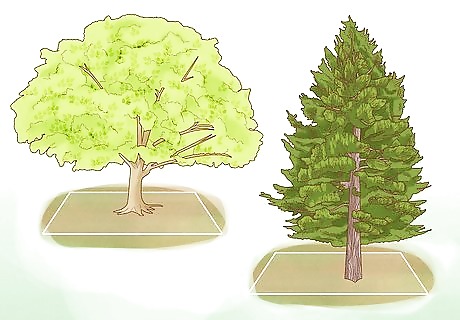
Search under beech, fir, and oak trees. Trees that form ectomycorrhizal (symbiotic) relationships with fungi, such as beech, fir, and oak trees, must be present in order for truffles to grow because truffles attach to tree roots. Pine, hazelnut, hickory, birch, and eucalyptus trees might also have truffles near them. Truffles share resources with these kinds of trees—truffles absorb water and nutrients that trees need, and trees have photosynthesizing leaves that make the food that truffles need. The kind of tree species truffles grow on depends on your area. In Oregon, they’re almost always found under Douglas fir trees.
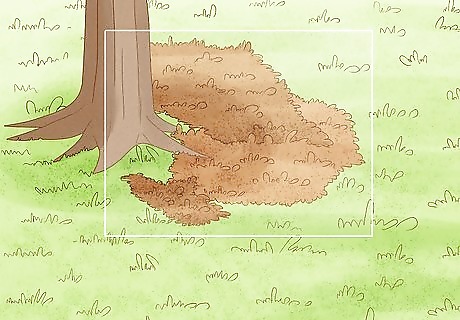
Look for darkened exposed dirt around the base of trees. As you hunt, look carefully at the ground to see if there are any trees without vegetation growing underneath them. If truffles are present, a “brûlée” effect may make the ground look burnt, rough, and darker than surrounding areas because their existence prevents vegetation from growing. When you find these “brûlée” areas, start carefully digging in the dirt with a trowel or hand rake to find truffles. Because tree roots can grow throughout a forest, truffles can be anywhere. While you hunt, look near rotting logs, abandoned roads, and in loose or compacted soil.

Check for small holes in or around the dirt. Look very carefully at the “brûlée” areas for small holes. This is a sign that rodents and other small mammals have been looking for the truffles. Seeing a lot of these may mean that rodents smelled the truffles’ strong aroma and began digging to find and eat them.
Identifying Truffles
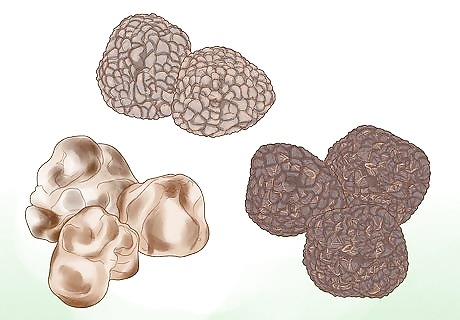
Truffles look like round potato-shaped lumps. There are thousands of different types of truffles that vary in size, but they’re most commonly black, white, or burgundy in color. You’ll know you’ve found a truffle when you find a lump underneath the ground that looks like a potato or chocolate truffle. Gareth Renowden Gareth Renowden, Premier Truffle Grower Many people are surprised to learn that truffles can be found growing wild, as their spore-laden fruit forms below the ground rather than above. Try to avoid eating a wild truffle or mushroom unless you or someone else has completely identified it. If you’re not sure what it is, wait to eat it until you do.
Harvesting Truffles
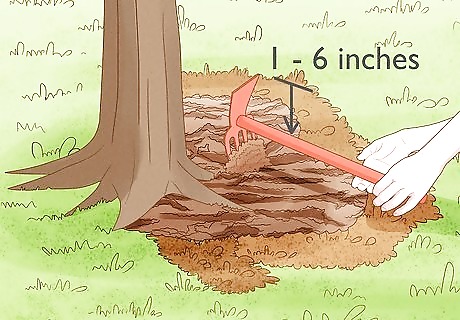
Dig truffles up with a rake. When you’ve found an area that you think may contain truffles, use a rake with 3 to 5 tines to gently peel back the layers of soil. Most truffles will be 1 to 3 inches (2.5 to 7.6 cm) deep. After raking, cover the soil back up to protect the roots of the tree and ensure there will be truffles there next season. Raking is the best way to hunt for truffles without a truffle dog or pig to help sniff them out. However, this method can pull up unripe or rotten truffles along with mature ones.
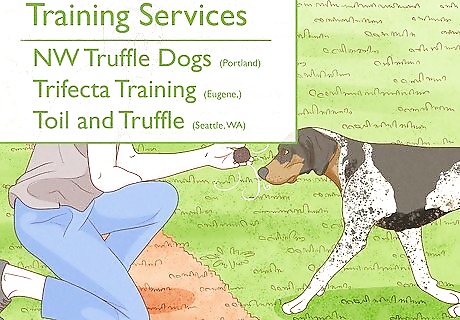
Train a truffle dog to help you hunt. Dogs can be a major asset because they only seek out ripe truffles and won’t dig up rotten or inedible truffles. To train your own truffle dog, pair the scent of truffles with a treat. Once they associate truffles with a reward, hide ripe truffles in containers and bury them under trees for your dog to find. Truffle training is best for puppies or young dogs, and some breeds are better at finding them than others. Lagotto Romagnolo dogs are especially skilled at truffle-hunting. Pigs are also good at finding truffles, but they’re much more difficult to train and they often eat the truffles.

Use an LED headlamp for nighttime truffle hunts. In the more popular searching areas in Italy or France, people dig all day every day hoping to find valuable truffles. If you want to search in one of these areas, consider searching during the night so that no one will be in your way. Simply put on an LED headlamp and get digging. If you take a truffle dog with you, make sure to attach an LED light to their collar.
Leave rotten and immature truffles in the ground. Mature truffles have a strong aroma and feel slightly spongy while rotting truffles are wet on the surface, feel very spongy, and may have a decaying smell. When you find a truffle patch, try to only scoop up mature truffles that are ready to eat. Although truffles are non-toxic, they can make you sick if you eat bacteria or mold growing on them. If truffles are slimy, sticky, mushy, or smell bad, put them back in the ground. Some underground mushrooms, like Scleroderma truffles, are false truffles that are poisonous. If you open a truffle and it has a powdery spore inside, leave it on the ground.
Note the location of the truffle patch so you can come back later. Truffle patches keep producing fungi for a few years. Write down the GPS coordinates of the patch and what kind of truffles you found there so you can come back after the next rainfall.
Cleaning and Storing Your Truffles
Brush off the dirt and put truffles in the fridge for up to 10 days. As soon as you find a truffle, use an old toothbrush or mushroom brush to gently clean the dirt off the surface. Put truffles in wax, cloth, or paper bags inside a cooler. When you get home, put them in an air-tight container with paper towels in the fridge. Most truffles will keep in the fridge for 10 days. White truffles last for around 5 days, while black truffles can stay ripe for about a week. Make sure the container has more air than truffles inside, and that no truffles touch each other. Replace the paper towels every 2 days. Try to avoid storing truffles in plastic bags. This can cause them to rot, get slimy, or mold. Because washing truffles can decrease their shelf life, it’s best not to wash them until you’re ready to use them or freeze them.
Wash and store your truffles in the freezer for up to 6 months. To preserve your truffles for longer than about 10 days, wipe them with a damp brush or cloth and dry them with a cloth or paper towel. Put them in air-tight containers in the freezer. Truffles will stay good for up to 6 months if kept frozen. When you’re ready to cook and eat them, cook them while they’re still frozen instead of thawing them out first.
Selling Truffles

Sell your truffles to upscale restaurants. Truffles are a popular culinary delicacy that is highly demanded and desired in expensive, upscale restaurants. Immediately after you find truffles, email or call restaurants in nearby cities to see if the chefs are interested in purchasing yours. The price of fresh truffles depends on the supply and demand, the species of truffle, and their quality. Italian White Alba truffles are the most expensive in the world and can be worth thousands of dollars a kilogram (2.2 lbs). Truffles are valuable because they’re seasonal, difficult to grow or find consistently, and take years to cultivate on farms.
Cooking with Truffles
Shave the truffles over your favorite pasta, risotto, or meat dish. Truffles are best consumed in small doses, like a condiment. Thinly shave or grate your truffles over a finished meal. You can also capture the truffle’s aroma by cooking the shavings in a fatty substance like butter, cream, cheese, egg yolks, or oil. White truffles have a delicate nutty flavor with hints of garlic, while black truffles are earthier and take like dark cocoa or licorice. Oregon truffles taste musty, like black olives or cocoa, and have a tropical undertone of banana or pineapple, which makes them great in desserts. Have your truffles identified by an expert before eating them.




















Comments
0 comment